The Discovery Mindblown Microscope Set is a kid-friendly STEM tool designed to inspire curiosity and learning. With magnifications up to 1200x‚ it reveals microscopic wonders‚ making science fun and accessible for young explorers.
1.1 Overview of the Microscope Set
The Discovery Mindblown Microscope Set is a comprehensive STEM tool designed for young scientists. It offers magnifications of up to 1200x‚ allowing users to explore microscopic details with clarity. The set includes a built-in light source‚ durable construction‚ and kid-friendly design. Perfect for educational projects‚ it enables students to examine samples like salt crystals‚ plant cells‚ and marine life. The microscope encourages hands-on learning‚ fostering curiosity and creativity in STEM fields. Its ease of use and safety features make it an ideal choice for both home and classroom environments.
1.2 Key Features and Specifications
The Discovery Mindblown Microscope Set features three magnification levels: 300x‚ 600x‚ and 1200x‚ providing detailed views of microscopic samples. It includes a built-in light source for clear illumination and a soft-touch design for enhanced safety. The microscope is equipped with a sturdy arm and base‚ ensuring stability during use. The set also comes with prepared slides and a user-friendly guide‚ making it easy for children to begin their scientific explorations. Additional accessories‚ such as a stage clip and focus knobs‚ ensure precise control over observations‚ enhancing the overall learning experience for young STEM enthusiasts.
1.3 Importance of Microscopes in STEM Education
Microscopes play a pivotal role in STEM education by fostering curiosity and hands-on learning. They allow students to explore the microscopic world‚ gaining insights into biology‚ chemistry‚ and environmental science. By observing samples like plant cells or salt crystals‚ young learners develop critical thinking and scientific inquiry skills. Microscopes also help students understand complex concepts visually‚ making abstract ideas more tangible. This interactive learning tool prepares future scientists and engineers‚ encouraging a deeper appreciation for the natural world and its hidden wonders.
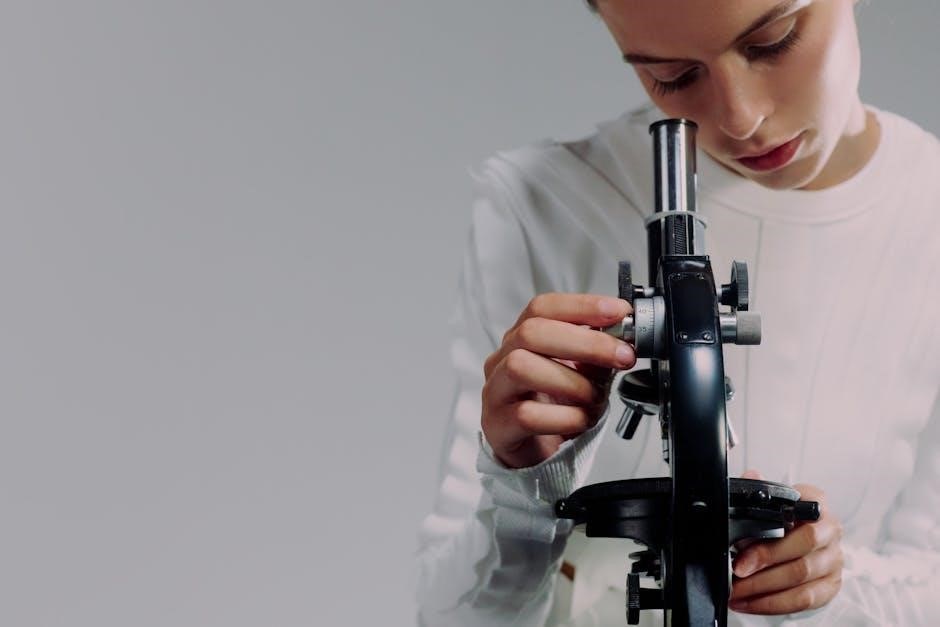
Unboxing and Initial Setup
The Discovery Mindblown Microscope Set includes a microscope‚ slides‚ and accessories. Carefully unbox and handle the microscope by its arm and base for safe setup.
2.1 What’s Included in the Box
The Discovery Mindblown Microscope Set includes a durable microscope‚ pre-prepared slides‚ a built-in light source‚ focus knobs‚ and an adjustable stage. The kit also contains a dropper for sample preparation and a guide for easy setup. Additional accessories like slide covers and a lens cleaning cloth are provided to ensure optimal performance. The microscope is designed for STEM learning‚ making it an excellent tool for young scientists to explore the microscopic world with clarity and precision.
2.2 Assembling the Microscope
Begin by carefully unboxing and identifying all components. Attach the eyepiece to the microscope arm‚ ensuring it clicks securely into place. Next‚ connect the objective lenses to the rotating turret. Gently screw the light source into the base and position the stage over the light. Align the stage clips to hold slides firmly. Finally‚ place the microscope on a stable surface and ensure all parts are secure. Always handle the microscope by the arm and base for safe assembly and transport.
2.3 Adjusting the Microscope Stand
Begin by positioning the microscope on a stable‚ flat surface. Loosen the adjustment knobs to lower or raise the stand. Ensure the base is balanced to prevent tilting. Once adjusted‚ tighten the knobs firmly. Always handle the microscope by the arm and base when moving it to avoid damaging the stand or other components. Proper adjustment ensures optimal viewing and stability during use. Check that the stage moves smoothly under the objective lens and that the light source is properly aligned with the stage opening. This ensures even illumination and clear focus. A stable setup is crucial for achieving sharp‚ clear images.
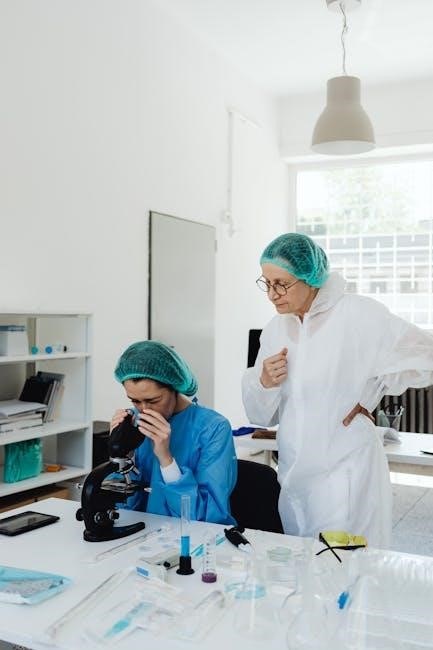
Understanding the Components
The Discovery Mindblown Microscope Set includes essential parts like the microscope arm‚ base‚ objective lenses‚ eyepiece‚ focus knobs‚ stage‚ and built-in light source‚ each playing a vital role in observation and functionality.
3.1 The Microscope Arm and Base
The microscope arm and base are sturdy‚ ensuring stability during use. The arm connects the eyepiece and objective lenses‚ while the base provides balance. To move the microscope‚ hold it by the arm and base for safe transfer‚ preventing damage. This design allows smooth adjustments and secure placement‚ making it durable for regular STEM activities and experiments‚ aligning with educational and exploratory needs for both kids and adults. Proper handling ensures longevity and optimal performance. Always handle with care to avoid accidental damage.
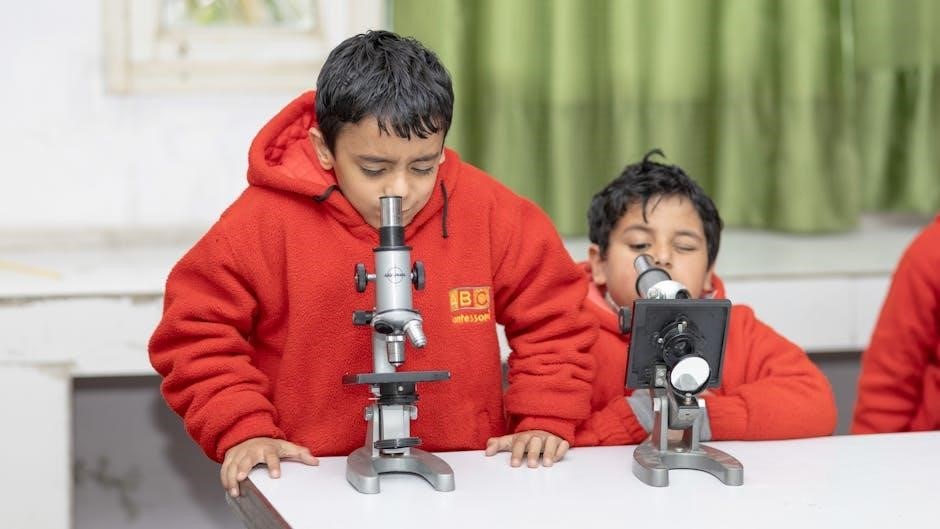
3.2 Objective Lenses and Eyepiece
The Discovery Mindblown Microscope Set features interchangeable objective lenses‚ offering magnification settings of 40X‚ 100X‚ and 400X. The eyepiece provides a clear view of samples‚ working in tandem with the objective lenses to deliver sharp images. Proper alignment and handling of these components are crucial for optimal performance. Always clean the lenses gently and avoid touching the glass surfaces to maintain clarity and precision during observations. These features make the microscope ideal for detailed STEM exploration and educational activities. Regular maintenance ensures long-term functionality and accuracy. Use the lenses responsibly to achieve the best results. Always store them securely when not in use. The combination of these components allows users to explore the microscopic world with ease and clarity‚ making learning engaging and effective. By following proper care and handling guidelines‚ users can extend the lifespan of the microscope and enjoy consistent performance. The objective lenses and eyepiece are essential for capturing vivid details‚ making them vital for any scientific investigation. Ensure they are free from dust and smudges for the best viewing experience. This design promotes hands-on learning and curiosity-driven exploration‚ aligning with the goals of STEM education. The microscope’s optical system is designed to provide a true view of samples‚ enhancing the learning process. Always handle the lenses with care to avoid scratches or damage‚ as they are delicate and essential for clear observations. By maintaining the quality of the objective lenses and eyepiece‚ users can continue to explore the microscopic world with precision and clarity. The microscope’s durability and ease of use make it a valuable tool for both students and educators. Proper care of these components ensures years of reliable service and exciting discoveries. The objective lenses and eyepiece are integral to the microscope’s functionality‚ providing the necessary tools for detailed and accurate observations. Always follow the manufacturer’s guidelines for cleaning and maintenance to preserve their quality. This attention to detail ensures that the microscope remains a reliable and essential tool for STEM learning. The combination of adjustable magnification and a clear eyepiece makes the microscope versatile for various experiments and activities. Users can explore everything from plant cells to microscopic marine life with ease. The objective lenses and eyepiece are designed to work seamlessly together‚ offering a comprehensive view of the microscopic world. By understanding and properly using these components‚ users can unlock the full potential of the microscope and enjoy a rewarding learning experience. The microscope’s optical system is built to deliver crisp and detailed images‚ making it an excellent choice for educational purposes. Regularly inspect and clean the lenses to ensure optimal performance. The Discovery Mindblown Microscope Set is designed to inspire curiosity and promote hands-on learning‚ with its objective lenses and eyepiece playing a central role in this mission. By caring for these components‚ users can continue to explore and discover the wonders of the microscopic world. The microscope’s durability and ease of use make it a valuable tool for both students and educators. Proper care of these components ensures years of reliable service and exciting discoveries. The objective lenses and eyepiece are integral to the microscope’s functionality‚ providing the necessary tools for detailed and accurate observations. Always follow the manufacturer’s guidelines for cleaning and maintenance to preserve their quality. This attention to detail ensures that the microscope remains a reliable and essential tool for STEM learning. The combination of adjustable magnification and a clear eyepiece makes the microscope versatile for various experiments and activities. Users can explore everything from plant cells to microscopic marine life with ease. The objective lenses and eyepiece are designed to work seamlessly together‚ offering a comprehensive view of the microscopic world. By understanding and properly using these components‚ users can unlock the full potential of the microscope and enjoy a rewarding learning experience. The microscope’s optical system is built to deliver crisp and detailed images‚ making it an excellent choice for educational purposes. Regularly inspect and clean the lenses to ensure optimal performance. The Discovery Mindblown Microscope Set is designed to inspire curiosity and promote hands-on learning‚ with its objective lenses and eyepiece playing a central role in this mission. By caring for these components‚ users can continue to explore and discover the wonders of the microscopic world.
3.3 Focus Knobs and Stage
The focus knobs allow precise adjustment of the microscope’s focus‚ ensuring clear and sharp images. The stage holds slides securely‚ with clips to keep samples in place. To focus‚ start with the coarse adjustment knob for rough alignment‚ then fine-tune with the fine adjustment knob. Always handle the stage gently and use the stage clips to prevent slides from moving. Proper use of these components is essential for achieving clear observations and maintaining the microscope’s performance. Regular cleaning of the stage and knobs helps prevent dust buildup and ensures smooth operation. By mastering the focus knobs and stage‚ users can optimize their microscopy experience and explore samples with clarity and precision. Proper alignment and handling are key to successful observations. Maintain these parts well to extend the microscope’s lifespan and functionality. The focus knobs and stage are vital for accurate and enjoyable microscopy‚ making them essential components in STEM learning and exploration. Always store the microscope correctly to protect these parts. This ensures reliable performance for future use. The focus knobs and stage are designed for ease of use‚ allowing users to concentrate on discovering the microscopic world. Their durability and functionality make them integral to the microscope’s design. By following proper handling and maintenance guidelines‚ users can fully utilize these features and enjoy a rewarding learning experience. The focus knobs and stage are central to the microscope’s operation‚ providing the necessary tools for detailed observations. Always clean and inspect these components regularly to ensure optimal performance. The Discovery Mindblown Microscope Set’s focus knobs and stage are built to deliver precise control‚ enhancing the learning process. By understanding and caring for these parts‚ users can unlock the full potential of the microscope and explore the microscopic world with confidence. The focus knobs and stage are designed to work seamlessly together‚ offering a comprehensive platform for sample analysis. Proper use and maintenance ensure years of reliable service and exciting discoveries. The focus knobs and stage are integral to the microscope’s functionality‚ providing the necessary tools for detailed and accurate observations. Always follow the manufacturer’s guidelines for cleaning and maintenance to preserve their quality. This attention to detail ensures that the microscope remains a reliable and essential tool for STEM learning. The combination of adjustable focus and a secure stage makes the microscope versatile for various experiments and activities. Users can explore everything from plant cells to microscopic marine life with ease. The focus knobs and stage are designed to work seamlessly together‚ offering a comprehensive view of the microscopic world. By understanding and properly using these components‚ users can unlock the full potential of the microscope and enjoy a rewarding learning experience. The microscope’s focus system is built to deliver crisp and detailed images‚ making it an excellent choice for educational purposes. Regularly inspect and clean the knobs and stage to ensure optimal performance. The Discovery Mindblown Microscope Set is designed to inspire curiosity and promote hands-on learning‚ with its focus knobs and stage playing a central role in this mission. By caring for these components‚ users can continue to explore and discover the wonders of the microscopic world. The focus knobs and stage are crucial for achieving clear and precise observations‚ making them essential for any scientific investigation. Ensure they are free from dust and debris for the best viewing experience. This design promotes hands-on learning and curiosity-driven exploration‚ aligning with the goals of STEM education. The microscope’s stage and focus system are designed to provide a true view of samples‚ enhancing the learning process. Always handle these parts with care to avoid scratches or damage‚ as they are delicate and essential for clear observations. By maintaining the quality of the focus knobs and stage‚ users can continue to explore the microscopic world with precision and clarity. The microscope’s durability and ease of use make it a valuable tool for both students and educators. Proper care of these components ensures years of reliable service and exciting discoveries. The focus knobs and stage are integral to the microscope’s functionality‚ providing the necessary tools for detailed and accurate observations. Always follow the manufacturer’s guidelines for cleaning and maintenance to preserve their quality. This attention to detail ensures that the microscope remains a reliable and essential tool for STEM learning. The combination of adjustable focus and a secure stage makes the microscope versatile for various experiments and activities. Users can explore everything from plant cells to microscopic marine life with ease. The focus knobs and stage are designed to work seamlessly together‚ offering a comprehensive view of the microscopic world. By understanding and properly using these components‚ users can unlock the full potential of the microscope and enjoy a rewarding learning experience. The microscope’s focus system is built to deliver crisp and detailed images‚ making it an excellent choice for educational purposes. Regularly inspect and clean the knobs and stage to ensure optimal performance. The Discovery Mindblown Microscope Set is designed to inspire curiosity and promote hands-on learning‚ with its focus knobs and stage playing a central role in this mission. By caring for these components‚ users can continue to explore and discover the wonders of the microscopic world. The focus knobs and stage are crucial for achieving clear and precise observations‚ making them essential for any scientific investigation. Ensure they are free from dust and debris for the best viewing experience. This design promotes hands-on learning and curiosity-driven exploration‚ aligning with the goals of STEM education. The microscope’s stage and focus system are designed to provide a true view of samples‚ enhancing the learning process. Always handle these parts with care to avoid scratches or damage‚ as they are delicate and essential for clear observations. By maintaining the quality of the focus knobs and stage‚ users can continue to explore the microscopic world with precision and clarity. The microscope’s durability and ease of use make it a valuable tool for both students and educators. Proper care of these components ensures years of reliable service and exciting discoveries. The focus knobs and stage are integral to the microscope’s functionality‚ providing the necessary tools for detailed and accurate observations. Always follow the manufacturer’s guidelines for cleaning and maintenance to preserve their quality. This attention to detail ensures that the microscope remains a reliable and essential tool for STEM learning. The combination of adjustable focus and a secure stage makes the microscope versatile for various experiments and activities. Users can explore everything from plant cells to microscopic marine life with ease. The focus knobs and stage are designed to work seamlessly together‚ offering a comprehensive view of the microscopic world. By understanding and properly using these components‚ users can unlock the full potential of the microscope and enjoy a rewarding learning experience. The microscope’s focus system is built to deliver crisp and detailed images‚ making it an excellent choice for educational purposes. Regularly inspect and clean the knobs and stage to ensure optimal performance; The Discovery Mindblown Microscope Set is designed to inspire curiosity and promote hands-on learning‚ with its focus knobs and stage playing a central role in this mission. By caring for these components‚ users can continue to explore and discover the wonders of the microscopic world.
3.4 Built-in Light Source
The built-in light source is a key feature of the Discovery Mindblown Microscope Set‚ providing reliable illumination for clear observations. It is energy-efficient and designed for extended use. To ensure optimal performance‚ adjust the brightness according to the sample’s transparency. Proper maintenance‚ such as replacing the bulb when necessary‚ is essential for longevity. Always avoid direct exposure to the light for extended periods to prevent overheating. This feature enhances the microscopy experience‚ making it ideal for STEM education and hands-on learning. Regular cleaning of the light source ensures consistent illumination‚ allowing users to explore the microscopic world with precision and clarity. By following care guidelines‚ the built-in light source remains a vital component for successful observations. Its durability and ease of use make it a valuable asset for both students and educators‚ fostering curiosity and scientific exploration. The built-in light source is integral to the microscope’s functionality‚ providing the necessary illumination for detailed and accurate observations. Always handle it with care to maintain its performance and extend its lifespan. This feature is designed to enhance the learning process‚ making it an essential part of the Discovery Mindblown Microscope Set.

Preparing for Observation
Preparing for observation involves selecting the right slides‚ ensuring proper lighting‚ and adjusting the stage to optimize sample visibility under the microscope for clear and detailed analysis.
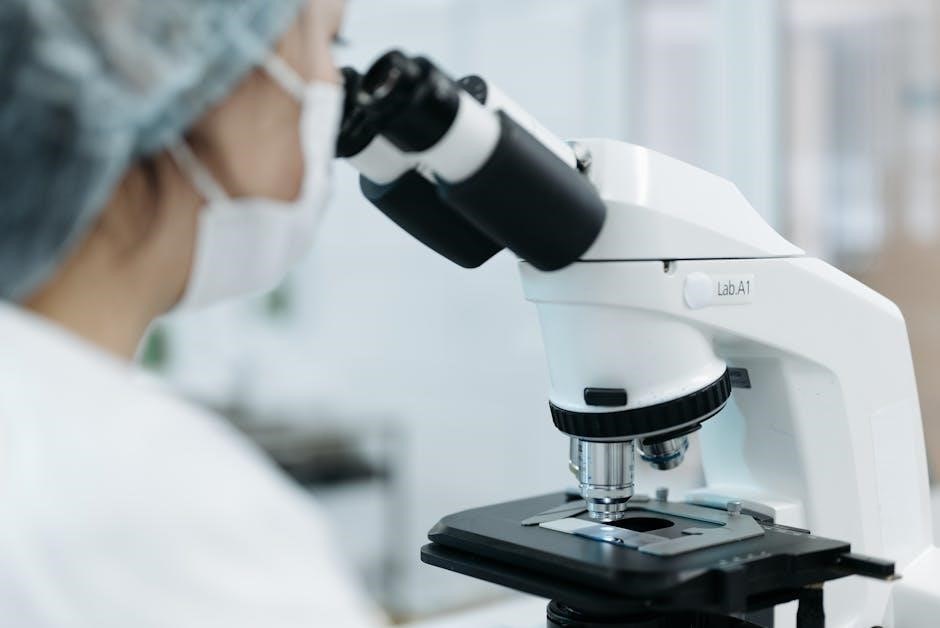
4.1 Choosing the Right Slides
When preparing for observation‚ selecting the right slides is crucial. Use prepared slides with labeled samples for clear results or blank slides for homemade samples. Ensure slides are clean and dry to avoid interference. For homemade slides‚ place a drop of water on the sample‚ cover with a cover slip‚ and gently press out air bubbles. This ensures optimal visibility under the microscope. Always handle slides carefully to prevent damage and store them in a protective case when not in use.
4.2 Using the Built-in Light
The built-in light source on the Discovery Mindblown Microscope Set is essential for illuminating samples. Turn it on and adjust the brightness using the controls. Position the light to evenly light the sample on the stage. Avoid direct eye exposure to the light. For transparent or semi-transparent samples‚ the light enhances visibility. For darker or opaque samples‚ adjust the light angle or intensity. Proper use ensures clear and detailed observations‚ making microscopic exploration engaging and effective for STEM learning.
4.3 Adjusting the Stage
Adjust the stage by gently turning the stage clips to secure the slide in place. Use the stage control knobs to move the slide left‚ right‚ up‚ or down‚ centering the sample under the objective lens. Ensure the slide is flat and evenly lit. For precise focus‚ start with the lowest magnification. Avoid touching the objective lens with your fingers or the slide. Proper stage alignment ensures clear observations and prevents damage to the microscope or samples‚ enhancing your STEM exploration experience.
Step-by-Step Usage Guide
Place the slide on the stage‚ secure it with clips. Focus using the coarse knob first‚ then fine-tune with the fine focus knob. Observe‚ then switch magnifications as needed. Always handle the microscope by the arm when moving it.
5.1 Placing the Slide on the Stage
To place the slide on the stage‚ first ensure the stage clips are open. Gently position the slide under the clips‚ aligning it with the stage’s center. Secure the slide by adjusting the clips firmly but carefully. Make sure the sample faces downward toward the objective lens. Handle the microscope by the arm when moving it to avoid shifting the slide. Once the slide is properly seated‚ the sample is ready for focusing. Always test with a prepared slide to ensure clarity and proper positioning.
5.2 Focusing the Microscope
Start by adjusting the coarse focus knob to bring the sample into view. Turn the knob slowly until the image becomes visible. Once in focus at low magnification‚ switch to higher magnification by rotating the objective lens. Fine-tune using the fine focus knob for clarity. Ensure the light is properly adjusted for optimal brightness. If the image blurs when changing magnifications‚ re-adjust the focus gently. Always handle the focus knobs with care to avoid damaging the microscope or the slide. Proper focusing enhances visibility and ensures a clear view of the microscopic world.
5.3 Observing the Sample
Once focused‚ carefully observe the sample through the eyepiece. Use the built-in light source to enhance visibility. Gently move the slide to explore different areas of the sample. Note the shapes‚ colors‚ and textures of the microscopic structures. For clearer views‚ ensure the light is evenly distributed. If needed‚ adjust the stage or light intensity. Take your time to thoroughly examine the specimen‚ as this step is crucial for learning and discovery. Proper observation helps uncover the fascinating details hidden in the microscopic world.
5.4 Switching Between Magnifications
To switch magnifications‚ locate the objective lenses on the microscope. Gently rotate the turret to select the desired lens (e.g.‚ 40X‚ 100X‚ or 400X). Ensure the slide is securely placed on the stage. After switching‚ adjust the focus knobs to clarify the image. For higher magnifications‚ fine-tune the focus slowly to avoid losing the sample. Use the built-in light to enhance visibility. Switching magnifications allows you to explore details at different scales‚ providing a deeper understanding of the specimen.
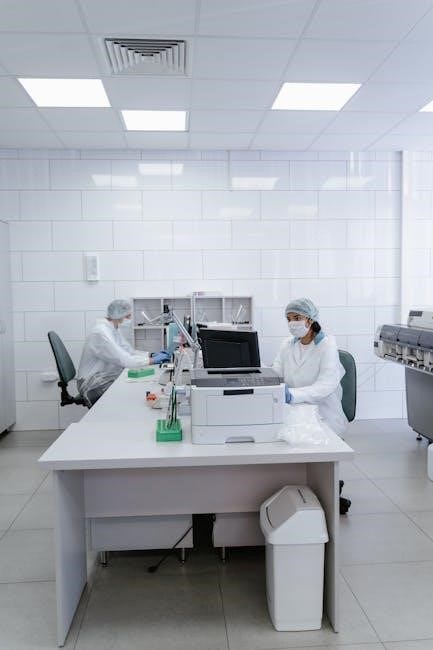
Preparing Your Own Slides
Collect samples like water drops or plant material. Create a wet mount by placing the specimen on a slide with a saline solution. Add stains for better visibility under the microscope‚ ensuring detailed observations.
6.1 Collecting Samples
When collecting samples for microscopic observation‚ it’s essential to use clean tools and handle specimens gently to avoid contamination. For water-based samples‚ like pond water or seawater‚ use a dropper to collect a small amount. Plant material‚ such as leaf or flower sections‚ can be carefully cut using a sharp blade. For marine samples‚ use rainwater or a saline solution to maintain their natural state. Always handle live specimens with care to preserve their integrity. Store collected samples in a clean‚ labeled container until ready for slide preparation.
6.2 Making a Wet Mount
To create a wet mount‚ place a drop of distilled or rainwater on a clean slide. Carefully add your sample‚ such as plant cells or marine organisms‚ to the water. Use a dropper to ensure the sample is fully submerged. Gently lower a coverslip over the sample to avoid air bubbles. This method preserves live specimens‚ allowing you to observe their natural movement under the microscope. For marine samples‚ a saline solution can be used to maintain their osmotic balance‚ ensuring they remain viable for observation.
6.3 Using Stains for Better Visibility
Stains enhance sample visibility by highlighting cellular structures. For plant cells‚ apply a few drops of iodine or methylene blue to the wet mount. Gently spread the stain with a clean slide or pipette. For marine life‚ use a saline solution to maintain osmotic balance. Avoid over-staining‚ as it can obscure details. After staining‚ carefully blot excess liquid with filter paper. This method improves contrast‚ making intricate details more visible under the microscope‚ especially for transparent or colorless specimens.

Safety Precautions
Ensure safe handling by holding the microscope by the arm and base. Avoid damaging the equipment and follow safety tips‚ especially for children‚ to prevent accidents.
7.1 Handling the Microscope Safely
Always handle the microscope by the arm and base to avoid accidental damage. Ensure the microscope is placed on a stable‚ flat surface before use. Never touch the objective lenses or eyepiece with bare hands‚ as oils from skin can cause damage. Use a soft‚ dry cloth to clean any external parts. Additionally‚ keep loose clothing and long hair tied back to prevent entanglement with moving parts. Proper handling ensures longevity and safe operation of the microscope for all users.
7.2 Avoiding Damage to the Equipment
To prevent damage‚ avoid touching the microscope’s lenses with bare hands‚ as skin oils can leave residue. Use a soft‚ dry cloth for cleaning; Never apply harsh chemicals or abrasive materials‚ as they may scratch surfaces. Store the microscope in a protective case or dry place when not in use. Avoid exposing it to extreme temperatures or moisture. Ensure the microscope is moved carefully by the arm and base to prevent accidental drops or bends. Regular maintenance and proper storage will extend the equipment’s lifespan and performance.
7.3 Safety Tips for Children
Adult supervision is essential when children use the microscope. Teach kids to handle the equipment gently‚ avoiding rough movements. Ensure they understand not to touch the lenses or use sharp objects near the microscope. Store the set out of reach of younger siblings or pets. Encourage children to use the microscope on a stable‚ flat surface to prevent accidents. Teach them to clean their hands before use and avoid placing foreign objects under the lens. Proper care and respect for the tool will ensure safe and enjoyable learning experiences.

Maintenance and Care
Regularly clean the microscope with soft cloths and avoid harsh chemicals. Store it in a dry‚ secure location to prevent damage. Replace the light bulb as needed.
8.1 Cleaning the Microscope
Use a soft‚ dry cloth to gently wipe down the microscope’s exterior and stage; For lenses‚ apply a small amount of lens cleaning solution to a microfiber cloth and carefully wipe in a circular motion. Avoid using harsh chemicals or abrasive materials that could scratch the surfaces. Regular cleaning prevents dust buildup and ensures optimal performance. After cleaning‚ use a dry section of the cloth to remove any residue or moisture‚ especially around the light source and eyepiece. This maintenance routine will extend the lifespan of your microscope and maintain its clarity.
8.2 Storing the Microscope Properly
To maintain the microscope’s condition‚ store it in a protective case or box when not in use. Place it in an upright position to prevent damage to the lenses or light source. Avoid storing it in humid‚ dusty‚ or direct sunlight-exposed areas. Use a soft cloth to wrap the microscope for added protection against scratches. Ensure the storage location is stable and out of reach from children or pets to prevent accidental damage. Proper storage ensures longevity and optimal performance of the microscope.
8.3 Replacing the Light Bulb
To replace the light bulb‚ first ensure the microscope is unplugged from the power source. Gently remove the bulb cover and carefully grasp the old bulb by its base. Avoid touching the glass to prevent oil residue. Insert the new bulb‚ ensuring it fits securely into the socket. Replace the cover and test the light by plugging in the microscope. Handle the bulb with care to avoid breakage and use a replacement bulb of the correct wattage and type specified in the manual.

Common Experiments and Activities
Explore microscopic marine life‚ observe salt crystals‚ and examine plant cells. These hands-on activities foster STEM learning‚ encouraging curiosity and a deeper understanding of the microscopic world.
